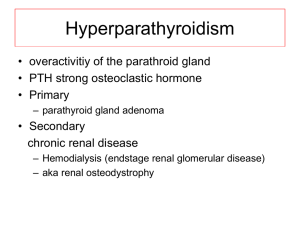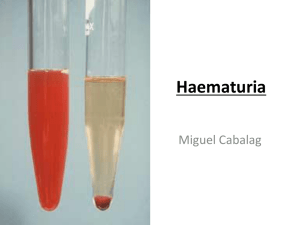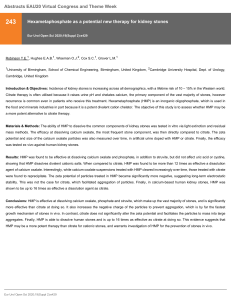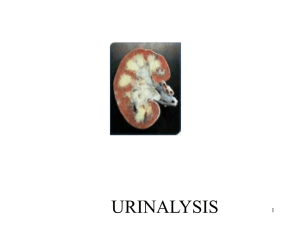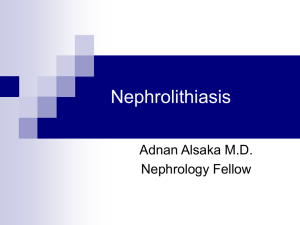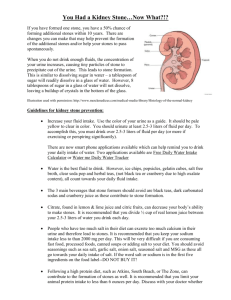Evaluation and Treatment of Renal Stones
advertisement
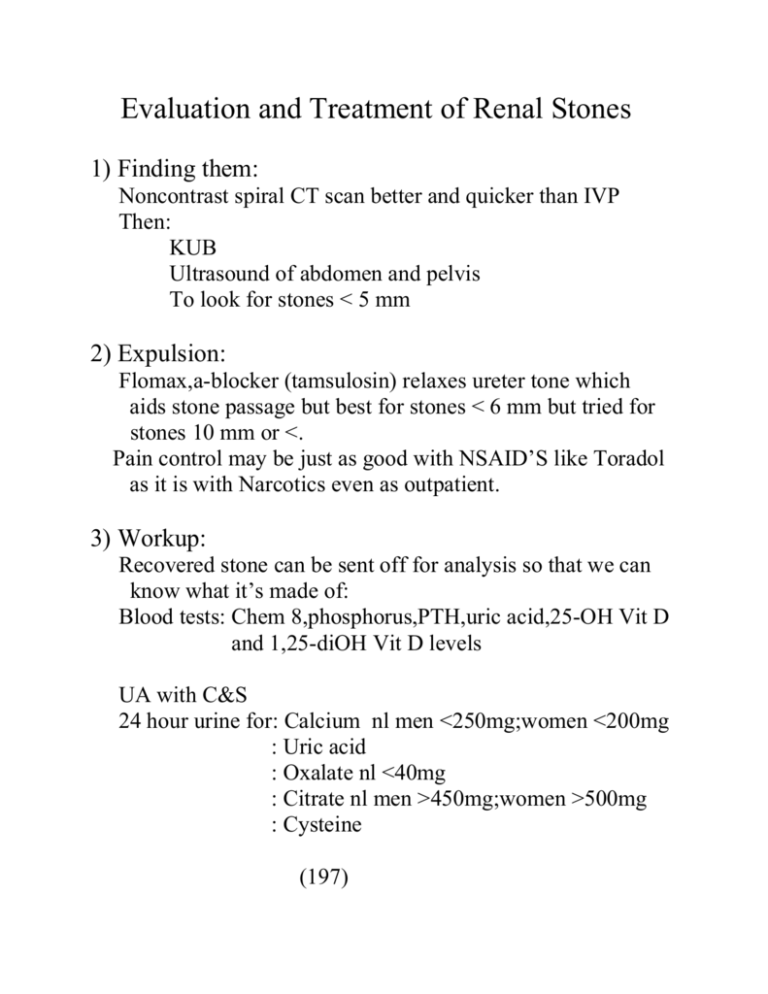
Evaluation and Treatment of Renal Stones 1) Finding them: Noncontrast spiral CT scan better and quicker than IVP Then: KUB Ultrasound of abdomen and pelvis To look for stones < 5 mm 2) Expulsion: Flomax,a-blocker (tamsulosin) relaxes ureter tone which aids stone passage but best for stones < 6 mm but tried for stones 10 mm or <. Pain control may be just as good with NSAID’S like Toradol as it is with Narcotics even as outpatient. 3) Workup: Recovered stone can be sent off for analysis so that we can know what it’s made of: Blood tests: Chem 8,phosphorus,PTH,uric acid,25-OH Vit D and 1,25-diOH Vit D levels UA with C&S 24 hour urine for: Calcium nl men <250mg;women <200mg : Uric acid : Oxalate nl <40mg : Citrate nl men >450mg;women >500mg : Cysteine (197) 4) Treatment: Absorptive hypercalciuria:from increased intestinal calcium absorption or PTH deficiency causing increased urinary calcium concentrations Type I Type II Type III (diet neutral) Tx thiazide or Tums (diet dependent) Tx protein/salt restriction or Tums (renal phosphate leak-decreased serum phosphorus with increased urine calcium) Tx thiazide Resorptive hypercalcuria:from excess PTH secretion due to a pituitary adenoma Tx parathyroid resection Renal hypercalcuiria:from renal insensitivity to PTH causing a secondary hyperparathyroidism just to maintain normal serum calcium at expense of increased urine calcium Tx thiazide &Tums (This Tx wasn’t in text but would boost serum calcium and exert a negative feedback on PTH secretion-could work) Hyperuricosuria/Gouty diathesis:from increased uric acid levels in acidic urine as with high purine diets or with chemtherapy.In this case both uric acid and calcium oxalate stones form, so the Tx involves alkalizing the urine with K+ citrate or Na+ bicarbonate as well as Allopurinol or Uloric (198) Hyperoxaluria:from urine oxalate >40mg in 24 hr urine due to overabsorption of oxalates from GI tract following small bowel resection or chronic diarrheal states where calcium is either absorbed or excreted too quickly to bind with oxalate so that the then calcium oxalate can be excreted safely in the stool rather than precipitating as renal stones. Tx Tums (Ca2+ to bind oxalate) (avoid tea,draft beer and black olives) Hypocitrauria:from lack of urinary citrate which is >450mg in men and >500mg in women that inhibits stone formation by complexing with calcium.Often occurs when patient is acidic which causes increased renal citrate reabsorption and less citrate synthesis. Tx Bicitra to alkalinize urine and oppose Acidosis Renal tubular acidosis:from inability to acidify urine or inability to reabsorb bicarbonate. Type I distal inability to acidify urine promotes bone & citrate reabsorption Type II proximal inability to reabsorp bicarbonate causes bicarbonate and citrate wasting Tx Bicitra and Tums because patient needs more calcium and acid neutralization Infectious stones:from urease splitting bacteria:Proteus,Klebsiella and Pseudomonas that produce magnesium ammonium phosphate stones. Tx treat infection and confirm clearance (199) Cystinuria:from genetic disorder of basic amino acid reabsorption in the proximal tubule. Tx keep well hydrated * 3 oz’s of lemon juice in water with added sugar for taste provides 63 meq’s of citrate to prevent stones from forming* (200)
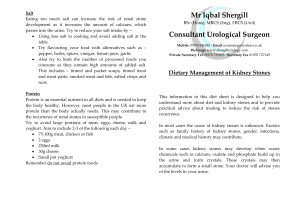
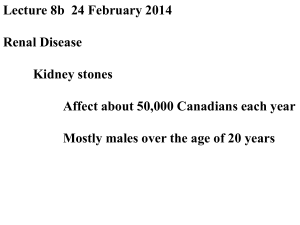

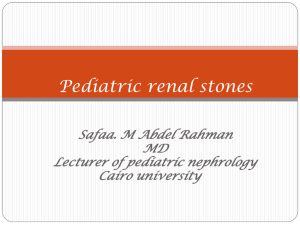
![2012 [1] Rajika L Dewasurendra, Prapat Suriyaphol, Sumadhya D](http://s3.studylib.net/store/data/006619083_1-f93216c6817d37213cca750ca3003423-300x300.png)
